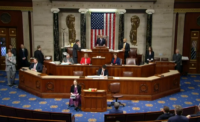A bill headed for Congress this summer aims to relieve student-loan debt for architecture graduates, while attracting new talent to nonprofit firms and community design centers. The National Design Services Act, first introduced in March 2014 by Representative Ed Perlmutter of Colorado and reintroduced this session at the end of June, would give the Secretary of Housing and Urban Development (HUD) authority to create a loan-repayment program for certain architects.
 |
| Photo © Jeffrey Totaro Representative Ed Perlmutter of Colorado introduced The National Design Services Act in March 2014. |
The American Institute of Architects (AIA) worked with Perlmutter’s office and the American Institute of Architecture Students (AIAS), says AIA manager of federal relations Ian McTiernan, to “develop legislation as a way to address debt load.” The effort followed a 2012 survey of AIAS members that found the average student-loan balance after graduation to be $40,000 or more. “The program is modeled after opportunities for doctors or lawyers to use their skills for community service,” he says.
Eligible architects would work for at least a year at a community design center—that is, a nonprofit managed by a licensed architect. Their work could include a wide range of community-development projects, including design of nongovernmental public facilities (libraries, schools, housing, health clinics, etc.), development or rehabilitation plans for blighted or deteriorating neighborhoods, preservation of historic sites, and retrofits for accessibility and energy or water efficiency. The HUD secretary would decide many other program specifics, including how to disburse funds (allocated by Congress) among applicants.
Korey White, 26, graduated from the University of Colorado Denver in 2013 with a dual master’s degree in architecture and urban planning and works for Path21 Architecture in Denver. Toward the end of graduate school, White found herself at a crossroads: to pursue the traditional internship-to-job path, or to work on the nonprofit side of architecture. “I opted to go with the ‘safer’ choice—an internship—because I knew in six months I’d have to start making payments,” she says.
“The debate around student loans has become a big issue,” says Noah Marine, Perlmutter’s legislative director, “and we want to be part of that overall discussion.” The bill has six cosponsors and is seeking more. It was referred to the House Committee on Financial Services at the end of June; if it survives, it would head to the House floor once Congress reconvenes after its August recess.
According to Marine, the National Design Services Act could also potentially be added as a provision to the Higher Education Act—if Congress considers reauthorization of that law, which governs federal student aid. “In this environment, it’s going to be difficult to move the bill as a standalone provision,” said Marine, “but we will be savvy.”



